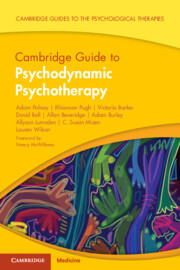Book contents
- Cambridge Guide to Psychodynamic Psychotherapy
- Cambridge Guides to the Psychological Therapies
- Reviews
- Cambridge Guide to Psychodynamic Psychotherapy
- Copyright page
- Dedication
- Contents
- Foreword
- Preface
- A Note from the Series Editor
- Acknowledgements
- Part 1: An Overview of the Model
- Part 2: The Model of Psychodynamic Psychotherapy into Practice
- Chapter 5 Framing a Psychodynamic Space
- Chapter 6 The Goals of Psychodynamic Psychotherapy
- Chapter 7 Psychodynamic Psychotherapy Technique
- Chapter 8 The Overall Structure of Psychodynamic Therapy
- Chapter 9 Psychological Assessment and Formulation in Psychodynamic Psychotherapy
- Chapter 10 Some Reflections on the Supervisory Process
- Part 3: Application for Mental Health Presentations
- Part 4: Application of Psychodynamic Psychotherapy in Different Populations and in Different Settings
- Glossary of Terms
- Index
- References
Chapter 8 - The Overall Structure of Psychodynamic Therapy
from Part 2: - The Model of Psychodynamic Psychotherapy into Practice
Published online by Cambridge University Press: 25 August 2023
- Cambridge Guide to Psychodynamic Psychotherapy
- Cambridge Guides to the Psychological Therapies
- Reviews
- Cambridge Guide to Psychodynamic Psychotherapy
- Copyright page
- Dedication
- Contents
- Foreword
- Preface
- A Note from the Series Editor
- Acknowledgements
- Part 1: An Overview of the Model
- Part 2: The Model of Psychodynamic Psychotherapy into Practice
- Chapter 5 Framing a Psychodynamic Space
- Chapter 6 The Goals of Psychodynamic Psychotherapy
- Chapter 7 Psychodynamic Psychotherapy Technique
- Chapter 8 The Overall Structure of Psychodynamic Therapy
- Chapter 9 Psychological Assessment and Formulation in Psychodynamic Psychotherapy
- Chapter 10 Some Reflections on the Supervisory Process
- Part 3: Application for Mental Health Presentations
- Part 4: Application of Psychodynamic Psychotherapy in Different Populations and in Different Settings
- Glossary of Terms
- Index
- References
Summary
It is one of the remarkable but also unsettling characteristics of psychodynamic psychotherapy that its course is not rigidly predetermined; this allows things to emerge in therapy that neither the therapist nor patient could have anticipated. What focus the work takes and what therapeutic approaches are most useful for each patient need to be found out along the way. This does not however mean it is impossible to give direction or that there is no structure to therapy. In this chapter, we aim to provide orientation to clinicians who are embarking on their first courses of therapy. We integrate theory and technique to offer a longitudinal perspective on how matters can play out over a course of therapy. Firstly, we discuss the formation of the therapeutic alliance and the development of a psychodynamic formulation. The central part of this chapter looks at the therapeutic relationship as a vehicle for change. Finally, we discuss the late phase of therapy and the dynamics of separation from the therapist, and how this can be both a challenging but productive period.
Keywords
- Type
- Chapter
- Information
- Cambridge Guide to Psychodynamic Psychotherapy , pp. 128 - 150Publisher: Cambridge University PressPrint publication year: 2023



